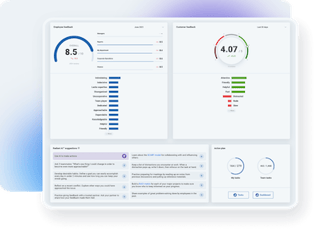
How to Conduct Effective One-on-One Meetings: 8 Proven Strategies for Delivering Constructive Feedback in a Hybrid World
Constructive feedback in the workplace encourages employee growth, performance improvements, and a positive workplace culture defined by continuous learning. Regularly providing constructive feedback has a profound impact on employee engagement. According to Gallup, 80% of employees who have “received meaningful feedback in the past week” consider themselves fully engaged.
Despite knowing the value of providing constructive feedback, managers do not always communicate performance expectations effectively. Engaging in performance management and providing continuous feedback have become even more challenging with the shift toward remote and hybrid work.
At the start of 2024, several major organizations (and countless smaller ones) announced sweeping return to office (RTO) initiatives. However, these initiatives quickly lost steam due to staunch resistance from thousands of workers.
When possible, most modern workers prefer remote or hybrid arrangements. According to Gallup, only 19% of U.S. workers with remote-capable jobs spend all of their time on-site. Over one-quarter (26%) are exclusively remote, and 55% are hybrid.
Hybrid work strategies seem to balance the preferences of workers and employers. These arrangements allow organizations to stay connected to employees while offering employees the benefit of flexibility.
When the workforce isn’t in the office full-time, business leaders turn to strategies that include remote work feedback loops, which enable managers to carry out effective one-on-one meetings and facilitate employee development through constructive feedback.
The aim of these one-on-one meetings is to foster employee engagement, not tension, through direct and empathetic feedback that clearly outlines a path forward for each employee.
For modern one-on-one meetings, leaders use a combination of AI-powered platforms, digital tools, and two-way communication to engage and motivate employees. Here are the eight best ways to incorporate constructive feedback into employee one-on-ones:

1. Utilize automated employee feedback software
Employee feedback software automates the feedback solicitation and delivery process, making it easier to collect and share feedback with employees. Modern feedback platforms organize ratings and comments on a single dashboard, providing both managers and employees access to the same reports. This shared access facilitates more effective and transparent one-on-one dialogues.
One of the challenges of giving constructive feedback is that the individual on the receiving end may brush off the feedback as manager bias, or “just one person’s opinion.” Turning performance reviews into 360-degree constructive feedback enhances their validity. By automating and organizing responses, performance management software mitigates concerns of manager bias in the feedback process.
With AI and machine learning tools enabled, providing constructive feedback with automated software is even easier. AI can analyze feedback patterns, predict employee performance trends, and collate these findings into personalized feedback suggestions for managers. This further reduces bias in the feedback process and provides even greater transparency for employees invested in improving their performance.
AI-driven feedback tools not only streamline the feedback process but also enhance the quality of interactions between managers and employees. Digital performance management solutions that integrate with common tools empower managers to automate the feedback loop and unlock the full potential of every employee.
For example, Macorva MX simplifies everyday management tasks with AI-generated action items and meeting agendas, while also generating performance reviews and personalized development plans. This empowers managers to efficiently support employee growth and conduct more meaningful one-on-one meetings.
2. Provide one-on-one coaching
One-on-one coaching empowers employees to improve by giving them a mentor instead of merely a manager, which is a priority for 83% of rising Gen Z talent when they look for a new job. By combining managing and coaching, one-on-one assessments can establish productive connections with employees, reinforcing a workplace culture focused on continuous learning.
One-on-one coaching is critical to the success of your workforce, regardless of where your employees are physically. According to the Society for Human Resource Management (SHRM), one-on-one coaching is one of the best ways to promote the well-being of remote employees while also keeping them more engaged.
Gathering and acting on employee feedback also plays an important role in employee engagement. Traditional annual reviews restrict the feedback process, but continuously addressing feedback through one-on-one coaching encourages employees to identify solutions and change their behavior over time.
Effective coaching strategies differ depending on the work environment, but some examples of how coaching can be introduced into one-on-one discussions include:
- Prioritizing open-ended questions in performance reviews
- Being specific about the challenges employees face
- Offering troubleshooting when they need support
- Developing a personalized action plan for each employee’s development
Macorva’s AI action planning and coaching solution empowers managers to implement impactful digital coaching strategies across hybrid and remote workforces. The platform is versatile enough to meet the needs of any organization, regardless of team size or location.
3. Identify training solutions
Often, managers opt for generalized criticism when providing constructive feedback. Rather than only identifying problems, managers should shift to offering tools to help employees improve their performance. This is especially vital in remote working conditions since employees lacking in-person interactions currently experience record lows in workplace engagement.
The right learning management system (LMS) will empower an organization to thrive in the changing work landscape. These versatile tools facilitate the delivery of standardized training content to the entire workforce, regardless of location.
Online courses are another valuable resource for businesses that need to deliver training content to remote and hybrid workers.
When looking for an LMS, prioritize platforms that integrate with employee experience software. This capability allows company leadership to gain a better understanding of the training needs and skills progression of their teams.
Virtual Training Resources
There are a plethora of virtual training resources your employees can take advantage of. Consider these options:
- LinkedIn Learning
- Coursera
- Udemy
Additionally, you can connect employees with free or low-cost resources such as industry-specific webinars and virtual workshops. Microlearning tools are another great resource, as these solutions allow your team members to complete short training tasks when their schedules allow.
4. Learn to ask questions
Asking questions can be a great way to incorporate constructive feedback into performance assessments. The right question can open a dialogue between workers and managers about their challenges with an internal process, skill, teammate, or objective, setting the stage for a productive discussion addressing their problem areas.
Managers just learning how to give constructive feedback may wonder how to phrase these questions to maximize their effectiveness. The important thing is to be open-ended and focused on the employee’s assessment of their experience in the workplace. Effective constructive feedback examples could include questions like these:
- How is your relationship with coworkers?
- Were you satisfied with the outcome of your last project?
- Do you think any of our workplace processes seem inefficient?
- Do you have any questions about your role?
- Are there any skills you hope to improve in your work?
- How do you feel about the communication within our team?
- Do you have any suggestions for improving our team's workflow?
And for specific remote/hybrid environments, you can ask:
- How do you balance remote and in-office work?
- What challenges do you face in our hybrid setup?
- Are any tools hindering your productivity in a hybrid environment?
- How effective are our virtual meetings for collaboration?
- Do you feel connected with your colleagues while working remotely?
- What improvements could enhance your remote work experience?

These remote worker feedback questions will help you turn feedback into an actionable strategy. Once you’ve explored the concerns and frustrations of your team, lean into user-friendly collaboration tools to solve the most significant challenges.
Video conferencing tools are great for encouraging open dialogue, but they are often underutilized. To take full advantage, get creative with your video chat tools.
For example, you can host real-time polls to speed up decision-making, use breakout rooms to facilitate sidebar conversations, and offer low-pressure video chat training sessions to make sure your team is comfortable using the tools you’ve provided them.
These constructive feedback examples are just a starting point. Managers should tailor their questions to align with specific objectives and remain open to receiving feedback themselves. This approach not only improves management strategies but also encourages employees to engage more openly, leading to better performance and satisfaction across the team.
5. Demonstrate empathy
One of the reasons employees might be resistant to feedback is because they need reassurance that their manager is “in their corner” and wants to help them succeed. By demonstrating empathy, you’re not only showing that you care about an employee’s success, but you’re also demonstrating that you can relate to their experiences and see things from their perspective.
Despite the crucial role empathy plays in any effective constructive feedback strategy, over half of employees report that corporate attempts to show empathy felt inauthentic. This means that empathetic statements are not enough to encourage meaningful change. Managers must learn to actively demonstrate empathy if they hope to reap its benefits.
When done effectively, one-on-one meetings provide an ideal opportunity to demonstrate empathy while providing constructive feedback. Phrasing feedback as a desire to help the employee improve, understand their situation, and see their perspective allows managers to open a more transparent dialogue about the problem areas the employee is experiencing.
Here are some of the ways that managers can connect with their employees and show empathy while giving constructive feedback:
- Use active listening techniques when providing constructive feedback, including making eye contact, asking follow-up questions, referring to what has already been discussed, and showing interest by listening more than speaking.
- Put yourself in the employee’s position when asking questions or delivering feedback.
- Offer suggestions for improvement without resorting to a critical or condescending demeanor.
- Relate to an employee’s struggle by offering guidance based on experience rather than always defaulting to judgment or criticism.
6. Encourage direct engagement
In a remote setting, subtle messages can easily be misinterpreted. Direct communication is essential to avoiding these misunderstandings and minimizing friction between team members.
Consider the message itself, as well as the tone and specific words chosen. Employees should know exactly where they stand, but feedback should be framed in a way that encourages improvement rather than making team members feel discouraged.
Keep these conversations solution-oriented. Let’s say that an employee is consistently missing deadlines. A vague message like “Make sure you stay on top of your deadlines” can come across as dismissive or unhelpful. You also can’t water down the feedback by reacting with, “No worries, just try to meet the next one.” At this point, missed deadlines have already become a recurring issue.
A more effective and constructive message might read as follows:
“I noticed you missed an important deadline last week, which affected our production schedule. Let’s talk about what challenges you’re facing and discuss some ways to help you meet deadlines moving forward.” This type of feedback holds the employee accountable but also offers a way forward.
Macorva's real-time feedback features make it easy for managers to deliver timely and direct messages to employees. With tools that provide suggested action plans and enable continuous performance evaluations, managers can engage in direct, responsive communication that addresses issues promptly.
These tools automate many of the administrative tasks associated with performance management, giving managers more time to compose and deliver actionable feedback. However, it is still up to managers to choose the right tone based on the situation. A solution-oriented tone that balances directness and sensitivity will be the most productive approach. The goal is to ensure that the employee is receptive to the feedback and motivated to improve.
7. Employ peer-to-peer feedback
Encouraging peer-to-peer feedback cultivates a more supportive team environment. Even the most direct and empathetic managers cannot fully trust a normal performance review since employees act differently around their supervisors.
Peer reviews provide deeper insights into the behavior and capabilities of each employee — capabilities that may not be evident in one-on-one evaluations.
Modern platforms such as Macorva offer 360-degree feedback solutions that streamline and enhance the peer review process. These tools categorize feedback by employee roles, helping managers identify performance gaps, assess team dynamics, and create a holistic picture of workplace contributions.
Managers can use peer feedback to reward collaboration while staying attuned to the overall workplace environment. Here are a few ways your business can make the most of this approach:
- Implement digital feedback platforms that allow for structured peer evaluations
- Provide an option for anonymous feedback to encourage employees to leave honest insights
- Educate employees on giving balanced and actionable feedback
- Moderate feedback to ensure it remains professional and constructive
- Integrate peer feedback into one-on-one meetings
Even anonymous peer feedback can make employees feel appreciated by their coworkers. Managers can use it to balance negative constructive feedback and provide a more balanced look at an employee’s strengths and weaknesses.
8. Make It SMART
SMART stands for specific, measurable, actionable, realistic, and time-bound. By following this acronym when giving constructive feedback, managers can ensure that performance expectations are clearly defined and well-understood by employees. When following SMART, constructive feedback can become a powerful catalyst for performance improvement and employee growth.
Here are examples of how to give constructive feedback using the SMART model:
- Specific: Unambiguously tell the employee the issue you hope to discuss, what you expect them to learn, and what options they have for addressing the issue.
- Measurable: Explain the specific results you expect to ensure they have heard and addressed the feedback.
- Actionable: Tie the feedback to specific corrective action they can take to fix the issue.
- Realistic: Focus the feedback on performance targets and omit trivial or overly critical observations that distract from the main issue.
- Time-bound: Convey a sense of urgency in the feedback by assigning a time frame in which you expect to see results.
To use a real-world example of SMART in action, Mass Medical Storage adopted Macorva’s AI-powered feedback management platform to go from inadequate survey participation to nearly 100% employee engagement in its new 360-degree feedback system. By using AI to process employee responses and identify priority improvement areas, Mass Medical successfully created a data-driven roadmap that enhanced employee satisfaction, boosted retention, and increased productivity using specific, actionable, and measurable feedback.

“My goal with doing unlimited 360-degree feedback as part of our survey was to figure out who are the top performers—not just from my perspective as a manager, but from their peers. Because the people who understand what’s really going on are the people actually involved in the process.”
Chief Executive Officer | Mass Medical Storage
Bonus tip: Embrace a Continuous Feedback Culture
Even organizations that do an excellent job of gathering employee feedback can encounter one or more fundamental problems with the way they collect, organize, and use that feedback.
One common mistake is relying on outdated methods, such as static online surveys or email chains, which can lead to fragmented data and delayed responses. This feedback tends to get lost in the shuffle, meaning that decision-makers rarely hear what employees’ concerns are until it has had a negative impact on company culture and worker morale.
Another mistake is asking for feedback only sporadically or when a major development is taking place (i.e., launching a new CRM platform). The point of gathering feedback from employees is to monitor the pulse of the organization and detect subtle shifts that could have lasting implications for the business.
Therefore, organizations need to create a culture that consistently encourages employees to share their views. Continuous feedback helps decision-makers identify and address concerning developments before they cause systemic issues within the organization.
Transitioning from old-school survey methods to digital feedback loops makes it easier for employees to participate while also ensuring that decision-makers can readily access feedback data.
With Macorva EX, you can create intelligent digital feedback loops while extracting full value from your data. The platform’s built-in AI tools convert data into strategic recommendations designed to maximize engagement, retention, and employee productivity. 
Maximize Engagement and Productivity With One-on-One Meetings
Constructive feedback is a powerful catalyst for performance improvement and employee growth. Delivering constructive feedback doesn’t have to be a stressful experience that leaves both parties feeling flustered, confused, or angry.
However, even ideal feedback must be effectively applied to actionable strategies to create the desired performance improvements. This is why tracking and measuring the impact of feedback on employee engagement and performance is so important. Employee engagement software that defines feedback metrics, tracks KPIs, and streamlines performance management can provide managers with the means to effectively engage with a changing workforce.
Whether employees work at home, in a company space, or within a hybrid model, managers need new ways to incorporate constructive feedback into their management model. These eight strategies represent effective practices that can be paired with management software solutions to take the pain out of feedback delivery. With the right tools, constructive feedback can become a dialogue that encourages an environment of continuous learning, ultimately strengthening the bonds between employees, managers, and the business.
Editors note: this blog was originally published in April 2019 and has been updated for accuracy and comprehensiveness.









